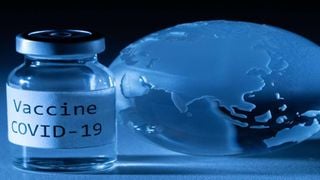
An illustration of a Covid-19 vaccine vial and an earth globe.
| AFPGuest Blogs
Premium
Is Kenya ready for a vaccine?
If vaccines landed at the Jomo Kenyatta International Airport (JKIA) today, what would we do with them? During a briefing on 16th November, Director-General of the Ministry of Health Dr Patrick Amoth stated that “we would need to revamp our entire system” to be able to deliver vaccines.
Given our decentralised health care delivery system, it is important to start with a nationwide preparedness assessment. This would determine how prepared counties are to receive, store, distribute and administer Covid-19 vaccines to the prioritised target groups. The hot spots and marginalised communities are of particular interest.
In terms of prioritisation, who will get the vaccine beyond health workers and those with underlying conditions? The prioritisation criteria will need to integrate several factors including:
- Health Workers – whether the cleaners and security workers guarding the health facilities, as well as community based workers, qualify under the 3 per cent allocation, among others.
- Pre-existing conditions – defining diseases which qualify as underlying factors such as sickle cell and other Kenyan context specific drivers of morbidity.
- Economic – expanding access to key sectors, i.e. tourism, agriculture, manufacturing, etc.
- Habitation/population density – priority to be given to those who live in the more congested informal settlements.
On infrastructure and operating systems, it is highly likely that several types of vaccines will be available in the same area, at the same time. Coordination is required to ensure that sufficient supplies and doses of each of the approved vaccines are stocked - when and where they are needed - to prevent delays and interruptions.
This includes fair distribution to counties based on disease burden and other objective criteria.
Also, since health workers are already limited and overstretched, we should consider recruiting and training another cadre of professionals to conduct outreach and dispense the vaccine. Last but not least, robust research, monitoring and evaluation system(s) should be established at national, county and community levels, anchored on a strong information technology (IT) infrastructure.
Logistics
The transport, energy, and health sectors form the core of the functional logistical infrastructure from the time the vaccines are manufactured, delivered to central storage points, distributed to counties and administered to a recipient at a specified location. This type of operation is best served by a command centre that is operated in partnership with private sector entities that have a strong logistics infrastructure.
Logistics would be anchored on a system of refrigerated trucks, warehouses, portable cool boxes, and other off-grid energy solutions. A system of advance planning and funding for operations would mitigate potential challenges/disruptions in distribution. Does the government have a framework for such a set-up? That’s a key question calling for an answer.
Then there is quality assurance or pharmacovigilance. Prior to COVID-19, the shortest time a vaccine is known to have been developed in is 4 years. The Covid-19 vaccines by Pfizer and others are being developed in 10 to 18 months due to the urgent need and an unprecedented global investment in research.
While safety and efficacy studies have been conducted under conditions of fidelity to high scientific standards required for approval, the period of monitoring before mass release has been considerably compressed. As such, a detailed monitoring and information management system, which tracks vaccinated persons for any potentially adverse effects, needs to be put in place as a matter of priority.
Lastly, a public campaign on availability and safety should be a priority. Anyone who has been in the field of public health is aware of how much can be accomplished by advocacy, social mobilisation, and risk communication. Advocacy is integral to raising awareness and creating trust.
A contextually targeted campaign that informs on availability and safety, as well as the importance of compliance (i.e. completing both doses) is required to mitigate vaccine hesitancy.
I have heard of stories of how the polio vaccine was rejected in Northern Nigeria because despite its efficacy, some Muslim communities there associated the development of the vaccine with pigs, which are repugnant to Islam followers.
In the same way, stories are now circulating of how the Covid-19 vaccine might be unsafe. It is important that surveys on knowledge, attitudes and practices be conducted as soon as possible to inform the public communication campaign to sensitise and educate on the safety and benefits of the vaccine.
We are behind in this vaccine race. Eight months after the first case on Covid-19 infection was reported, we still do not have adequate personal protective equipment (PPE) in the hospitals.
This has resulted in public sector doctors issuing a 21-day strike notice. Yet, procurement and distribution of PPE is far less complex than that of vaccines.
Kenya should seriously intensify the preparedness efforts because the vaccines come. It is just a matter of time.




